traction control Acura RL 2000 3.5 Owner's Manual
[x] Cancel search | Manufacturer: ACURA, Model Year: 2000, Model line: RL, Model: Acura RL 2000Pages: 330, PDF Size: 4.53 MB
Page 59 of 330
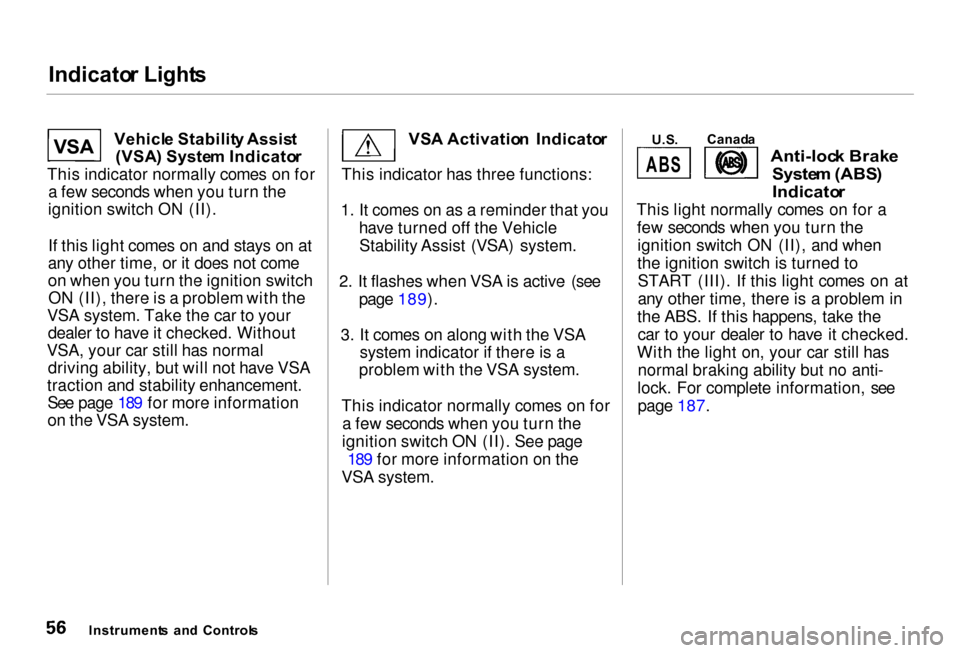
Indicato
r Light s
Vehicl e Stabilit y Assis t
(VSA ) Syste m Indicato r
This indicator normally comes on for a few seconds when you turn the
ignition switch ON (II).
If this light comes on and stays on at
any other time, or it does not come
on when you turn the ignition switch ON (II), there is a problem with the
VSA system. Take the car to your dealer to have it checked. Without
VSA, your car still has normal driving ability, but will not have VSA
traction and stability enhancement. See page 189 for more information
on the VSA system. VS
A Activatio n Indicato r
This indicator has three functions:
1. It comes on as a reminder that you have turned off the VehicleStability Assist (VSA) system.
2. It flashes when VSA is active (see page 189).
3. It comes on along with the VSA system indicator if there is a
problem with the VSA system.
This indicator normally comes on for a few seconds when you turn the
ignition switch ON (II). See page 189 for more information on the
VSA system.
Anti-loc
k Brak e
Syste m (ABS )
Indicato r
This light normally comes on for a few seconds when you turn theignition switch ON (II), and when
the ignition switch is turned toSTART (III). If this light comes on at
any other time, there is a problem in
the ABS. If this happens, take the car to your dealer to have it checked.
With the light on, your car still has normal braking ability but no anti-
lock. For complete information, see page 187.
Instrument s an d Control s
V
SA
U.S
.
Canad
a
AB S
Page 189 of 330
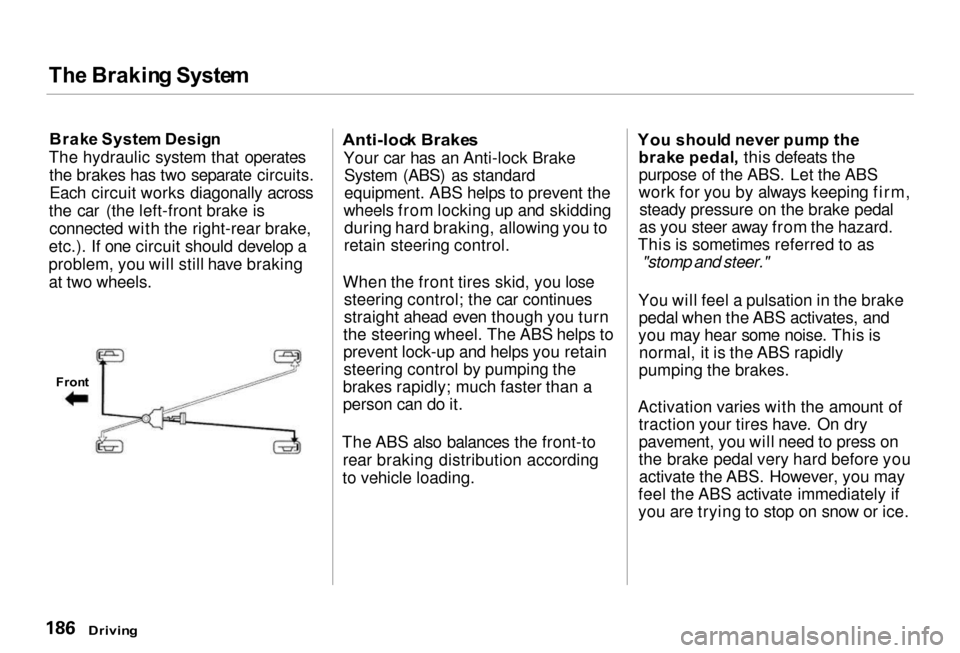
Th
e Brakin g Syste m
Brak e Syste m Desig n
The hydraulic system that operates the brakes has two separate circuits.Each circuit works diagonally across
the car (the left-front brake is connected with the right-rear brake,
etc.). If one circuit should develop a
problem, you will still have braking at two wheels.
Anti-loc
k Brake s
Your car has an Anti-lock Brake System (ABS) as standard
equipment. ABS helps to prevent the
wheels from locking up and skidding during hard braking, allowing you to
retain steering control.
When the front tires skid, you lose steering control; the car continues
straight ahead even though you turn
the steering wheel. The ABS helps to
prevent lock-up and helps you retain steering control by pumping the
brakes rapidly; much faster than a
person can do it.
The ABS also balances the front-to rear braking distribution according
to vehicle loading. Yo
u shoul d neve r pum p th e
brak e pedal , this defeats the
purpose of the ABS. Let the ABS
work for you by always keeping firm, steady pressure on the brake pedal
as you steer away from the hazard.
This is sometimes referred to as
"stomp and steer."
You will feel a pulsation in the brake pedal when the ABS activates, and
you may hear some noise. This is normal, it is the ABS rapidly
pumping the brakes.
Activation varies with the amount of traction your tires have. On dry
pavement, you will need to press on
the brake pedal very hard before youactivate the ABS. However, you may
feel the ABS activate immediately if
you are trying to stop on snow or ice.
Drivin g
Fron
t
Page 192 of 330

Vehicl
e Stabilit y Assis t (VSA ) Syste m
The Vehicle Stability Assist system helps to stabilize the vehicle duringcornering if the car turns more or
less than desired. It also assists you
in maintaining traction while
accelerating on loose or slippery
road surfaces. It does this by
regulating the engine's output, and
by selectively applying braking.
When VSA activates, you may notice that the engine does not respond to
the accelerator in the same way itdoes at other times. You will also see
the VSA Activation Indicator blink.
For a technical description of the
Vehicle Stability Assist System, see
page 300.
The VSA system cannot enhance the
car's driving stability in all situations
and does not control your vehicle's
entire braking system. It is still your
responsibility to drive and corner at
reasonable speeds and to leave a sufficient margin of safety. VSA Activation Indicator
VSA ACTIVATIO N INDICATO R
When VSA activates, you will see the VSA Activation indicator blink.
CONTINUED
Drivin g
Page 195 of 330
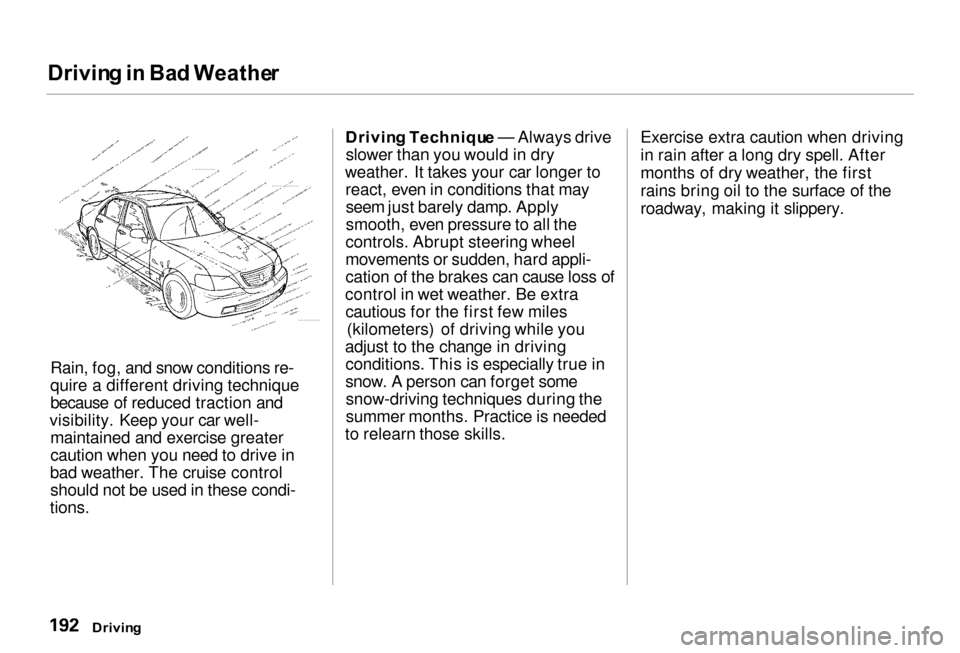
Drivin
g in Ba d Weathe r
Rain, fog, and snow conditions re-
quire a different driving technique
because of reduced traction and
visibility. Keep your car well- maintained and exercise greater
caution when you need to drive in
bad weather. The cruise control should not be used in these condi-
tions. Drivin
g Techniqu e — Always drive
slower than you would in dry
weather. It takes your car longer to react, even in conditions that mayseem just barely damp. Apply
smooth, even pressure to all the
controls. Abrupt steering wheel
movements or sudden, hard appli-
cation of the brakes can cause loss of
control in wet weather. Be extra cautious for the first few miles (kilometers) of driving while you
adjust to the change in driving conditions. This is especially true in
snow. A person can forget somesnow-driving techniques during the
summer months. Practice is needed
to relearn those skills. Exercise extra caution when driving
in rain after a long dry spell. After
months of dry weather, the first
rains bring oil to the surface of the
roadway, making it slippery.
Drivin g
Page 196 of 330
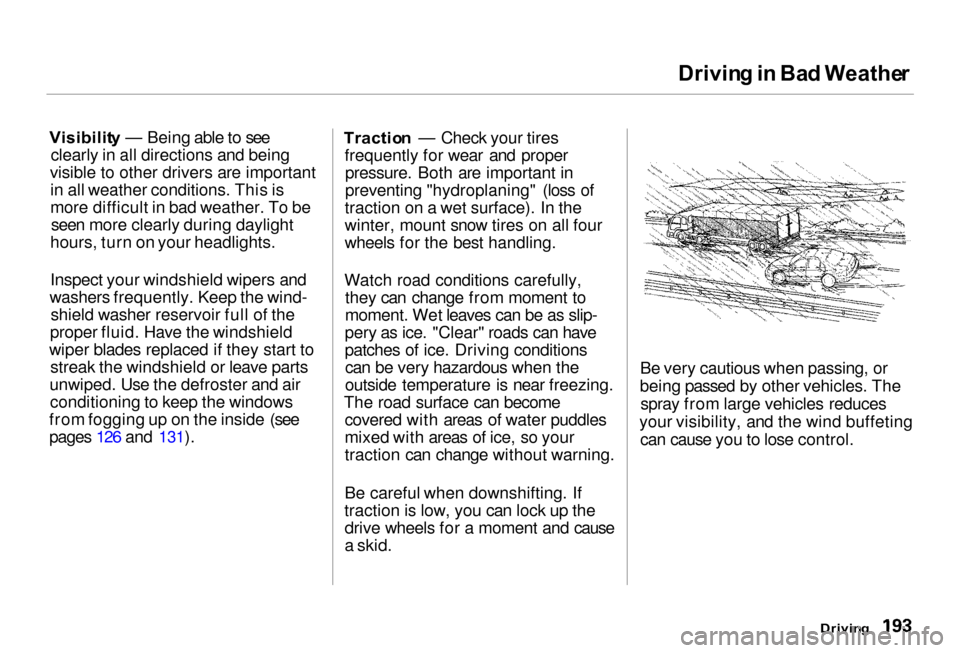
Drivin
g in Ba d Weathe r
Visibilit y — Being able to see
clearly in all directions and being
visible to other drivers are important in all weather conditions. This is
more difficult in bad weather. To be seen more clearly during daylight
hours, turn on your headlights.
Inspect your windshield wipers and
washers frequently. Keep the wind- shield washer reservoir full of the
proper fluid. Have the windshield
wiper blades replaced if they start to streak the windshield or leave parts
unwiped. Use the defroster and air conditioning to keep the windows
from fogging up on the inside (see
pages 126 and 131). Tractio
n — Check your tires
frequently for wear and proper pressure. Both are important in
preventing "hydroplaning" (loss of
traction on a wet surface). In the
winter, mount snow tires on all four
wheels for the best handling.
Watch road conditions carefully, they can change from moment to
moment. Wet leaves can be as slip-
pery as ice. "Clear" roads can have
patches of ice. Driving conditions can be very hazardous when the
outside temperature is near freezing.
The road surface can become covered with areas of water puddles
mixed with areas of ice, so your
traction can change without warning.
Be careful when downshifting. If
traction is low, you can lock up the drive wheels for a moment and cause
a skid. Be very cautious when passing, or
being passed by other vehicles. The spray from large vehicles reduces
your visibility, and the wind buffeting can cause you to lose control.
Driving
Page 197 of 330

Towin
g a Traile r
Your Acura has been designed primarily to carry passengers and
their cargo. You can use it to tow a
trailer if you carefully observe the
load limits, use the proper equipment, and follow the guidelines in this
section.
Loa
d Limit s Tota
l Traile r Weight : The total
weight of the trailer and everything loaded in it must not
exceed 2,000 Ibs (900 kg). Towing
a load that is too heavy canseriously affect your car's
handling and performance. It can also damage the engine and
drivetrain. Tongu
e Load : The weight that
the tongue of a fully-loaded trailer
puts on the hitch should be approximately 10 percent of the
trailer weight. Too little tongue
load can make the trailer unstable and cause it to sway. Too much
tongue load reduces front-tire
traction and steering control.
To achieve a proper tongue load, start by loading 60 percent of the
load toward the front of the trailer and 40 percent toward the rear, then
readjust the load as needed.
Drivin g
Page 298 of 330
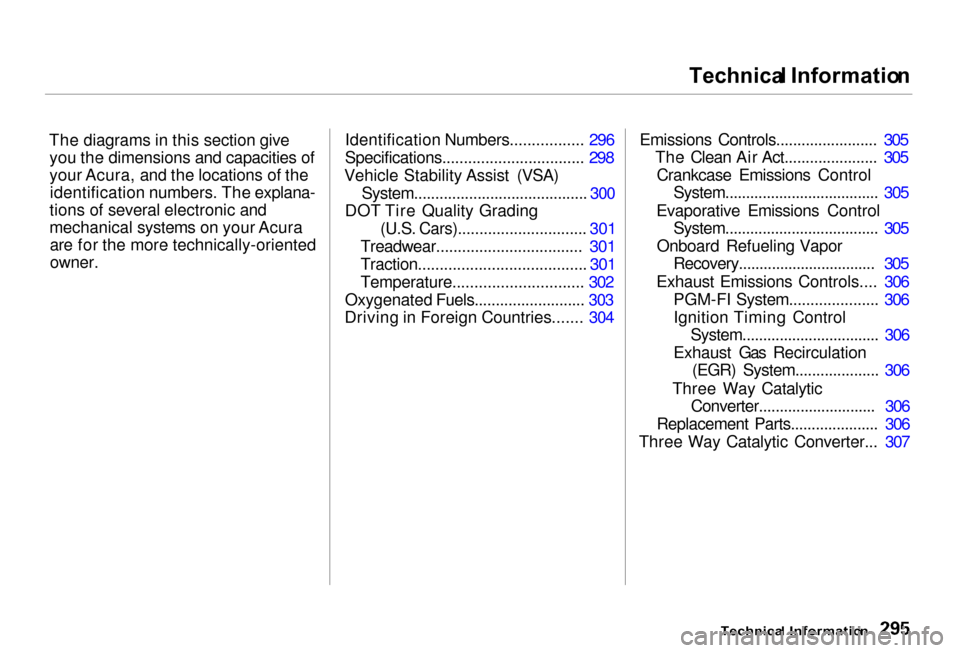
Technica
l Informatio n
The diagrams in this section give you the dimensions and capacities of
your Acura, and the locations of theidentification numbers. The explana-
tions of several electronic and
mechanical systems on your Acura are for the more technically-oriented
owner. Identification Numbers................. 296
Specifications................................. 298
Vehicle Stability Assist (VSA) System......................................... 300
DOT Tire Quality Grading
(U.S. Cars).............................. 301
Treadwear.................................. 301
Traction....................................... 301
Temperature.............................. 302
Oxygenated Fuels.......................... 303
Driving in Foreign Countries....... 304 Emissions Controls........................ 305
The Clean Air Act...................... 305
Crankcase Emissions Control System..................................... 305
Evaporative Emissions Control System..................................... 305
Onboard Refueling Vapor Recovery................................. 305
Exhaust Emissions Controls.... 306 PGM-FI System..................... 306
Ignition Timing ControlSystem................................. 306
Exhaust Gas Recirculation (EGR) System.................... 306
Three Way Catalytic Converter............................ 306
Replacement Parts..................... 306
Three Way Catalytic Converter... 307
Technical Informatio n
Page 303 of 330

Vehicl
e Stabilit y Assis t (VSA ) Syste m
The Vehicle Stability Assist system (VSA) monitors the car's actions
during straight-line acceleration and
cornering behavior. It reduces
engine power and applies selective
braking if it senses any loss of
traction.
Controllin g Tractio n Durin g
Straight-lin e Acceleratio n
If one drive wheel is turning faster
than the other, or both drive wheels
are turning faster than the non- driven wheels, VSA senses
wheelspin. It reduces engine power and applies braking at the wheels as
necessary to increase traction.
To do this, VSA monitors the pulse frequencies from the wheel speed sensors. It also uses information
from the steering wheel angle sensor
and the lateral acceleration sensor to determine if the car is accelerating in
a straight line or if it is cornering.
VSA can then calculate how much wheelspin, if any, to allow. It signals
the ECU to reduce fuel flow andretard ignition timing. This reduces
available engine power. The ECU
will also apply braking at the wheels as necessary. When wheelspin has
been controlled, braking and engine
control return to normal.
Controllin g Tractio n Durin g
Cornerin g
VSA monitors steering input and the car's expected response to that input.
VSA's yaw rate sensor measures the car's actual cornering behavior. If VSA determines that the car is
turning more or less than expected,
the system reduces engine power
and applies braking at the
appropriate wheel to try and
maintain adequate traction during
cornering.
VSA uses the same wheel speed sensor assemblies as the ABS.
Additional sensors measure steering wheel angle, lateral acceleration, and
yaw rate.
The control unit monitors the VSA circuitry while driving. If it senses a
problem, it turns off the system and illuminates the VSA System
Indicator on the instrument panel.
Technica l Informatio n
Page 304 of 330

DO
T Tir e Qualit y Gradin g (U.S . Cars )
The tires on your car meet all U.S. Federal Safety Requirements. All
tires are also graded for treadwear,
traction, and temperature perform- ance according to Department of
Transportation (DOT) standards.
The following explains these
gradings.
Unifor m Tir e Qualit y Gradin g
Quality grades can be found where
applicable on the tire sidewall
between the tread shoulder and the
maximum section width. For
example:
Treadwea r 20 0
Tractio n A A
Temperatur e A
Treadwea
r
The treadwear grade is a compara- tive rating based on the wear rate of
the tire when tested under controlled
conditions on a specified government
test course. For example, a tire
graded 150 would wear one and one
half (1-1/2) times as well on the
government course as a tire graded 100. The relative performance of
tires depends upon the actual condi-
tions of their use, however, and may depart significantly from the norm
due to variations in driving habits,
service practices, and differences in
road characteristics and climate.
Tractio
n
The traction grades, from highest to lowest, are AA, A, B, and C. Those
grades represent the tire's ability tostop on wet pavement as measured
under controlled conditions onspecified government test surfaces
of asphalt and concrete. A tire
marked C may have poor traction
performance.
Warning: The traction grade assigned to this tire is based onstraight-ahead braking traction tests,
and does not include acceleration,
cornering, hydroplaning, or peak
traction characteristics.
Technical Informatio n